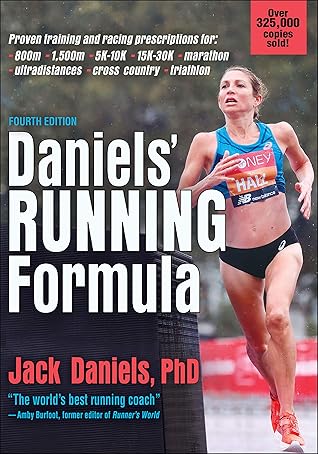More on this book
Community
Kindle Notes & Highlights
altitudes affect the sport of running.
That 3 percent loss in body weight was not much for a 26-mile run.
being at altitude affects the body in a few different ways, and the following points are worthy of consideration.
once you have gone through the process of learning how to race at altitude, that will stay with you fairly permanently; you tend to remember how best to race in this environment.
Upon arrival at altitude, one’s aerobic capacity (O2max) is reduced by about 12 to 16 percent, but a runner’s performance is affected by only about 6 to 8 percent.
the “cost” (aerobic demand) of running is less at altitude compared to sea level, as a result of the less dense air
there are five intensities of training: E (easy) runs, M (marathon-pace runs, mostly for marathon specialists), T (threshold pace), I (interval pace), and R (repetition pace).
One of the biggest advantages of treadmill running is that you can accurately control intensity.
A big advantage treadmill running has over ground running is in the area of hill training.
downhill running increase landing shock.
Downhill running can easily increase quadriceps muscle soreness if you are going too fast or running down more than just a few degrees of grade.
Use the following heart-rate rankings: 1 = up to 80 percent of max HR, 2 = 81 to 85 percent of max, 3 = 86 to 90 percent of max, 4 = 91 to 99 percent of max, and 5 = max HR, or about equal to current mile race pace effort.
Rest—but not avoidance—is an essential part of your training.
Consistency with regard to rest, nutrition, and training is the key to achieving maximum benefits from a program.
Never train when injur...
This highlight has been truncated due to consecutive passage length restrictions.
there is no problem with daily running,
Table 8.2 provides a detailed structure of the red training plan. E represents easy running, and L represents a long run that is easy and steady. Strides (ST) are light, quick 15- to 20-second runs (not sprints) with 45 to 60 seconds of rest between each. Intervals (I) are hard runs at a pace you could race at for 10 to 15 minutes. T represents threshold pace, which is a comfortably hard pace you could handle for 40 minutes, and jogs (jg) should be run at an easy pace. K refers to kilometer.
BLUE ADVANCED PLAN
Table 8.3 details the blue training program. E represents easy running, and L represents a long run that is easy and steady. Strides (ST) are light, quick 15- to 20-second runs (not sprints) with 45 to 60 seconds of rest between each. R represents repetition running at a pace that you could race at for 5 minutes. Hard runs are interval in nature and at a pace you could race at for 10 to 15 minutes. T represents threshold pace, which is comfortably hard, and jogs (jg) should be run at an easy pace. K refers to kilometer.
rest can be considered part of training, rather than an avoidance of training,
there are two categories of breaks from training—planned breaks and unplanned breaks.
it is not advisable to jump right back into the volume of training you were doing before the time off started.
don’t try to work extra hard to make up for lost time.
Staying healthy is rule number 1 when you are not exercising as much as you normally do.
performing half-squats with relatively light weights can improve
running performance.
Current VDOT dictates training speeds, and as you race better, your training VDOT increases.
as you spend time away from training, current VDOT will also deteriorate to some degree.
the greatest benefit of leg strengthening is to build a resistance to common running injuries.
some resistance work can actually improve running economy
running on too steep of a downhill course or on hard road surfaces can increase your chance of hurting areas in your hips, knees, and feet.
When running downhill, it is important to avoid overstriding;
uphill running can be on just about any steepness of slope because you are not really pounding into the ground as hard as on a flat surface,
you get the benefit of strengthening the pushing-off muscles and the hip flexors, while reducing the landing shock associated with flat or downhill running.
nothing leads to running injury more quickly than poor running mechanics.
give your body a good 4 weeks at one level of training stress before increasing that stress—it’s better to undertrain than to overtrain.
Push-Ups
The circuit starts with half of your 1-minute maximum of push-ups.
Side Leg Lifts
10 side leg lifts with each leg.
High Knees
30 high knee lifts with each leg while running in place (figure
Crunches
half of your 1-minute maximum of crunches.
Recovery Run and Stretch
1-minute run or a 400-meter run.
Squat Thrusts
10 squat thrusts (burpees).
Leg Lifts
10 leg lifts with each leg,


